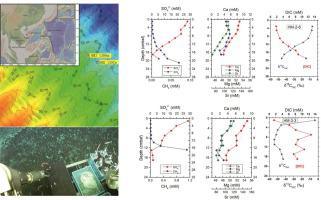当前位置:
X-MOL 学术
›
J. Asian Earth Sci.
›
论文详情
Our official English website, www.x-mol.net, welcomes your
feedback! (Note: you will need to create a separate account there.)
Pore-water dissolved inorganic carbon sources and cycling in the shallow sediments of the Haima cold seeps, South China Sea
Journal of Asian Earth Sciences ( IF 2.7 ) Pub Date : 2020-10-01 , DOI: 10.1016/j.jseaes.2020.104495 Weining Liu , Zijun Wu , Sinan Xu , Jiangong Wei , Xiaotong Peng , Jiangtao Li , Yiqing Wang
Journal of Asian Earth Sciences ( IF 2.7 ) Pub Date : 2020-10-01 , DOI: 10.1016/j.jseaes.2020.104495 Weining Liu , Zijun Wu , Sinan Xu , Jiangong Wei , Xiaotong Peng , Jiangtao Li , Yiqing Wang

|
Abstract Pore-water geochemical compositions provide the insights into seafloor cold seep activities and biogeochemical processes of methane-derived carbon in sediments. In this study, six sediment push cores were collected by manned submersible at the center and edge of the active Haima cold seeps, and a nearby background site. Pore-water compositions of the SO42−, Ca2+, Mg2+, Sr2+, NH4+, dissolved inorganic carbon (DIC), and δ13C-DIC at each sediments core were measured. The very shallow depths of sulfate–methane transition zone (SMTZ) suggest that high methane flux and significant anaerobic oxidation of methane (AOM) activities occur in the shallow sediments. Reaction-transport modelling results show that the relative contributions of AOM and organoclastic sulfate reduction (OSR) consuming sulfate are 84.1% and 15.9% at site HM-2-6, and 94.6% and 5.4% at site HM-3-3, respectively. Furthermore, extremely low δ13C-DIC values at the central sites HM-2-6 (−45.67‰) and HM-3-3 (−53.87‰) indicate an external methane-derived DIC. Based on the δ13C mass balance, we quantify the proportions of pore-water DIC derived from organic matter degradation and AOM as 24.7% and 65.3% at site HM-2-6, and 9.3% and 80.7% at site HM-3-3, respectively. An increase in pore-water DIC concentration leads to carbonate precipitation. Plots of Sr/Ca vs. Mg/Ca ratios reveal that the carbonate phases in sediments are dominantly high Mg-calcite in this region. Our study demonstrates that AOM can serve as a dominant biogeochemical process through incorporation of methane-derived carbon into dissolved and solid inorganic carbon phases, significantly influencing DIC cycling within the shallow sediments of the Haima cold seep area.
中文翻译:

南海海马冷泉浅层沉积物中孔隙水溶解无机碳源及循环
摘要 孔隙水地球化学成分提供了对海底冷渗活动和沉积物中甲烷衍生碳的生物地球化学过程的见解。在这项研究中,载人潜水器在活跃的海马冷泉中心和边缘以及附近的背景地点收集了六个沉积物推芯。测量了每个沉积物核心的 SO42-、Ca2+、Mg2+、Sr2+、NH4+、溶解无机碳 (DIC) 和 δ13C-DIC 的孔隙水组成。硫酸盐-甲烷过渡带(SMTZ)的非常浅的深度表明,在浅层沉积物中发生了高甲烷通量和显着的甲烷厌氧氧化(AOM)活动。反应传输模型结果表明,在 HM-2-6 和 94 站点,AOM 和有机碎屑硫酸盐还原 (OSR) 消耗硫酸盐的相对贡献分别为 84.1% 和 15.9%。HM-3-3 站点分别为 6% 和 5.4%。此外,中心位点 HM-2-6 (-45.67‰) 和 HM-3-3 (-53.87‰) 的极低 δ13C-DIC 值表明外部甲烷衍生的 DIC。基于δ13C质量平衡,我们将有机质降解和AOM衍生的孔隙水DIC的比例量化为HM-2-6站点的24.7%和65.3%,HM-3-3站点的9.3%和80.7% , 分别。孔隙水 DIC 浓度的增加导致碳酸盐沉淀。Sr/Ca 与 Mg/Ca 比的图显示,该地区沉积物中的碳酸盐相主要是高镁方解石。我们的研究表明,通过将甲烷衍生的碳结合到溶解和固体无机碳相中,AOM 可以作为主要的生物地球化学过程,
更新日期:2020-10-01
中文翻译:

南海海马冷泉浅层沉积物中孔隙水溶解无机碳源及循环
摘要 孔隙水地球化学成分提供了对海底冷渗活动和沉积物中甲烷衍生碳的生物地球化学过程的见解。在这项研究中,载人潜水器在活跃的海马冷泉中心和边缘以及附近的背景地点收集了六个沉积物推芯。测量了每个沉积物核心的 SO42-、Ca2+、Mg2+、Sr2+、NH4+、溶解无机碳 (DIC) 和 δ13C-DIC 的孔隙水组成。硫酸盐-甲烷过渡带(SMTZ)的非常浅的深度表明,在浅层沉积物中发生了高甲烷通量和显着的甲烷厌氧氧化(AOM)活动。反应传输模型结果表明,在 HM-2-6 和 94 站点,AOM 和有机碎屑硫酸盐还原 (OSR) 消耗硫酸盐的相对贡献分别为 84.1% 和 15.9%。HM-3-3 站点分别为 6% 和 5.4%。此外,中心位点 HM-2-6 (-45.67‰) 和 HM-3-3 (-53.87‰) 的极低 δ13C-DIC 值表明外部甲烷衍生的 DIC。基于δ13C质量平衡,我们将有机质降解和AOM衍生的孔隙水DIC的比例量化为HM-2-6站点的24.7%和65.3%,HM-3-3站点的9.3%和80.7% , 分别。孔隙水 DIC 浓度的增加导致碳酸盐沉淀。Sr/Ca 与 Mg/Ca 比的图显示,该地区沉积物中的碳酸盐相主要是高镁方解石。我们的研究表明,通过将甲烷衍生的碳结合到溶解和固体无机碳相中,AOM 可以作为主要的生物地球化学过程,











































 京公网安备 11010802027423号
京公网安备 11010802027423号